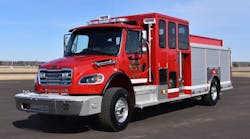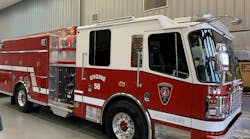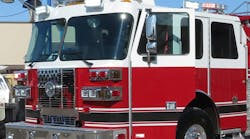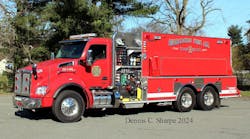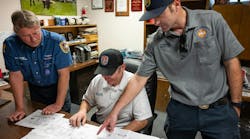At first, I felt a sense of profound sadness. Then questions ran through my mind at one hundred miles per hour. Were any firefighters injured or killed? Were any civilians involved? How did the accident happen? What was on fire? Were there any injuries or worse at the scene of the fire? How did this accident affect the outcome at the fire scene? How badly damaged was the pumper? Could it be fixed? Would the apparatus be a total loss? What effect would this accident have on the fire department members? What would the long term hold in store for the fire department?
The accident occurred as the apparatus was enroute to a working truck fire on the interstate. This accident was the result of several factors. The apparatus operator was new and inexperienced. As he drove over the interstate just before entering the cloverleaf, he could see the working truck fire. This caused a high level of excitement at the same time that the rear wheels went off the road shoulder into loose soft gravel.
As the vehicle slipped into the soft gravel, the weight of the water, gravity and the speed of the apparatus catapulted the apparatus onto its roof. The accident resulted in minor injuries to the two firefighters on board the apparatus, but caused the apparatus to be a total loss. The accident also resulted in a delayed response to the original truck fire - but the truck was a total loss before the fire department was ever dispatched.
In this first column in a series we will examine some recent apparatus rollover accidents. Subsequent columns will discuss the factors that contributed to these accidents and actions that can be taken to reduce the number of these types of accidents.
A Virginia firefighter was killed when the rescue apparatus in which he was a passenger rolled over enroute to a report of a gas leak. The firefighter had less than one year of service in this combination department. The accident occurred at about 7:45 P.M. on a winding two-lane road. The rescue rig flipped over on its side after leaving the road and crashing into trees. Two civilian vehicles were also involved in the crash, but there were no civilian injuries. The driver of the rescue was 29 years old and had 11 years of service as a volunteer with the fire department. The driver, who received head and leg injuries, was treated at a hospital and released.
The rescue unit was among seven fire trucks dispatched to investigate a gas leak inside a private dwelling. As the rescue was responding, the operator lost control; the rig veered off the right side of the road and struck a culvert. At this point, the operator attempted to guide the truck back onto the roadway, but overcorrected and the apparatus veered into the oncoming lane. With the fire truck heading toward two oncoming cars, the civilian drivers began taking evasive action, trying to veer to their right and out of the path of the truck. The first civilian driver could not get over far enough, and the fire truck sideswiped this vehicle. The second civilian vehicle sustained damage when it went off the road in an attempt to avoid a collision with the fire truck. Meanwhile, the apparatus operator continued to struggle to bring the apparatus under control. Apparently, he tried to steer it back into his lane of travel. The apparatus ran off the right side of the road, flipped over and struck a tree.
The firefighters aboard the six other units responding to the gas leak were unaware of the crash. The emergency involved a leak from a gas stove. The fire chief stated, "The piping had become separated in the wall and it was a significant call."
On the afternoon of Tuesday, Aug. 31, 1999, a South Carolina firefighter was killed and two other firefighters were injured when the operator of their pumper, responding to a report of a vehicle accident, lost control and the rig overturned several times.
The 34-year-old driver was an eight-year veteran of the volunteer fire department. The accident occurred when the driver lost control of the unit as the wheels went off the right side of the road. As he attempted to compensate, the apparatus veered to the left across a yard and another road, flipping over and landing in another yard. No other vehicles were involved. It took crews about and hour to extricate the driver from the wreckage. Two other firefighters onboard the apparatus at the time of the wreck suffered less serious injuries and were treated and released from an area hospital. The fire truck was reportedly traveling about 50 mph in a 35-mph zone. Officials also noted that none of the firefighters were wearing seatbelts.
On Sunday, May 3, 1999, a 28-year-old volunteer firefighter in North Carolina was killed when the pumper he was driving left the roadway, overturned and struck a tree. The six-year fire department veteran left behind a wife and a young child. He was trapped in the wreckage for several hours.
The incident occurred while the unit was returning to the station. The volunteer fire department was dispatched to a motor-vehicle accident involving injuries. The assistant chief, who was first to arrive via his private vehicle, assessed the scene and determined that no one was injured. He canceled the response of the rescue and the engine, which were enroute to the scene. While driving to the station, the driver apparently steered the engine toward the shoulder of the road to provide more room for oncoming traffic. As he approached the shoulder, the right-rear dual tires went off the road. This was due to the insufficient road shoulder and the steep incline of the ditch beside the road (common in much of rural America). Continuing off the road and into the ditch for approximately 280 feet, the engine overturned onto the passenger side, striking a large tree. The driver of the apparatus was killed instantly. He was driving an apparatus with a 1000-gallon, T-shaped tank with baffles.
A 28-year-old Louisiana volunteer firefighter died on Dec. 15, 1999, when he lost control of the fire department tanker he was driving while responding to a grass fire. The driver of the 1,500-gallon tanker lost control on a curve. As he went off the road, the shoulder gave way under the right wheels of the tanker. As the operator tried to regain control and get the tanker back on the roadway, it flipped and rolled sideways before ejecting the driver from his seat. The tanker rolled over 11/2 times before skidding upside down 200 yards down the road. The driver was thrown 170 yards from where he was ejected and pronounced dead on the scene.
On Wednesday Nov. 17, 1999, at 3:30 P.M., eight Pennsylvania firefighters were injured when a pumper overturned while enroute to a barn fire. One of the firefighters was critically injured and trapped under the apparatus for nearly an hour. The pumper, which carried 1,000 gallons of water, was destroyed in the accident. The driver of the pumper is 60 years old and has 42 years of emergency vehicle driving experience.
The accident occurred on a dry, cold day. Accident-reconstruction experts determined the truck was moving at about 54 mph when it traveled around a sharp bend in the road, near an intersection. The right tires traveled off the roadway, but the truck kept moving, partially on and off the roadway, for about 300 feet. In an attempt to regain control, the operator steered to the left and the vehicle traveled into the oncoming lane of traffic. Then the operator steered sharply to the right, but the truck began to overturn. It traveled another 105 feet in its original lane of traffic before slamming into the ditch and slicing through dozens of trees for another 116 feet, where it came to rest. At least four of the firefighters were thrown from the apparatus as it overturned; sources said none of the firefighters were wearing seatbelts. For one of the young firefighters, it was only his second call. It would appear that most if not all of the firefighters were ejected and thrown from or under the vehicle.
On Jan. 17, 2000, a 47-year-old volunteer firefighter in Missouri was fatally injured when the pumper (carrying 600 gallons) that he was driving overturned end over end. The pumper was responding on mutual aid to a working house fire when the accident occurred at 3:35 P.M. Officials stated that the engine was traveling west when the operator lost control of the vehicle, struck the guardrail and overturned. The officials also stated that the apparatus rolled end over end at least twice and wound up in a drainage area. It must also be noted that the road appeared to be a little slick from the mist that had been falling most of the afternoon. It was also theorized that the water in the tank was sloshing, and that the driver overcorrected and lost control.
As we were going to press, we learned of the tragic death of 27-year-old Firefighter Evan Shirk. Firefighter Shirk, a five-year veteran, was returning from a medical call when the engine he was driving overturned several times, causing fatal injuries. Our heartfelt sympathies go out to Firefighter Shirk's expectant wife and two young children, and to the officers and members of the Moreau Fire Protection District in Eldon, MO. May he rest in peace.
Accidents To Be Reviewed
The next Emergency Vehicle Operations column will take an in-depth look at these accidents, highlighting the similarities and the differences. Most importantly, we will publish the lessons that were learned and/or reinforced from these tragedies.
I would respectfully ask any readers who have emergency vehicle accident pictures or slides, whether they are police, fire or EMS, to send them to me in care of Firehouse® Magazine. Your efforts will help in the continuing process of educating emergency vehicle operators.
Finally, I look forward to seeing you at the Firehouse Emergency Services Expo in Baltimore later this month.
Michael Wilbur, a Firehouse® contributing editor, is an FDNY lieutenant in Ladder Company 27 in the Bronx and a firefighter in the Howells, NY, Fire Department. He is an adjunct instructor at the New York State Academy of Fire Science and the Orange County Fire Training Center. Wilbur has developed and presented emergency vehicle operator courses throughout the country and has consulted on a variety of fire apparatus issues.

